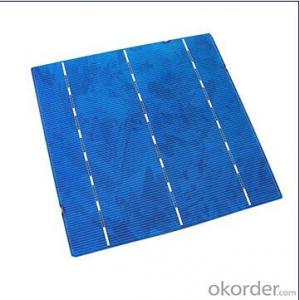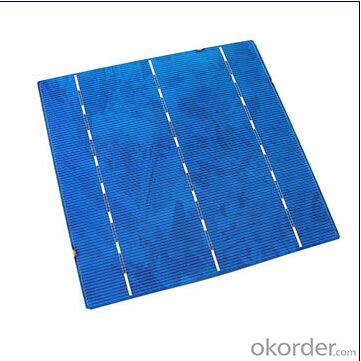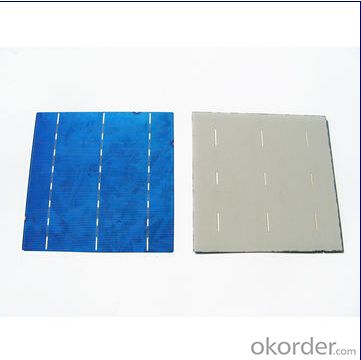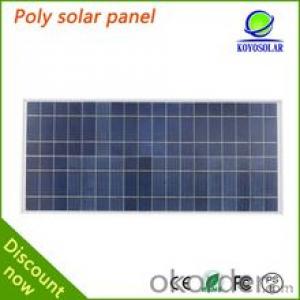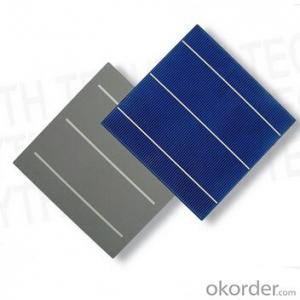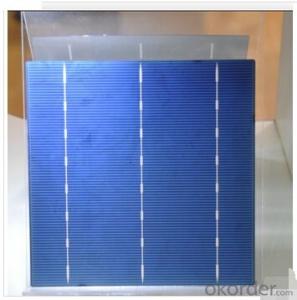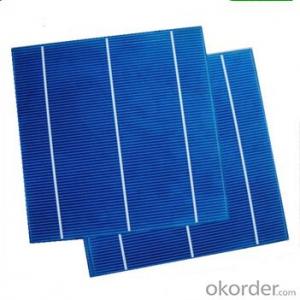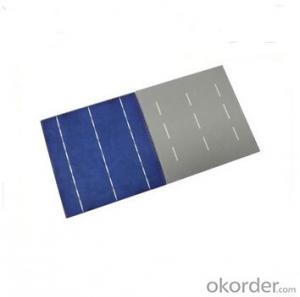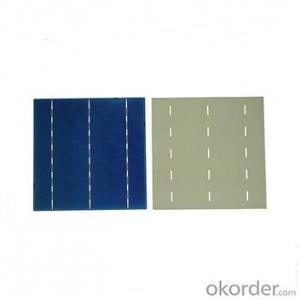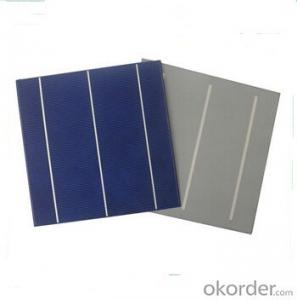Buy Solar Cells in Bulk - Polycrystalline Solar Cells Series C 16.80%
- Loading Port:
- Shanghai
- Payment Terms:
- TT OR LC
- Min Order Qty:
- 3000 pc
- Supply Capability:
- 300000 pc/month
OKorder Service Pledge
OKorder Financial Service
You Might Also Like
Solar Cells:
Solar cells is made by solar wafer, it has three categories of solar cell right now, monocrystalline polycrystalline and thin film,These cells are entirely based around the concept PN junction, which is the critical part of solar module, it is the part that can convert the light energy into electricity, the thickness is from 180um to 200um, with even busbars to conduct electricity, textured cell can decrease diffuse reflection; they are often electrically connected and encapsulated as a module. Photovoltaic modules often have a sheet of glass on the front (sun up) side, allowing light to pass while protecting semiconductor wafers from abrasion and impact due to wind-driven debris, rain, hail, etc. Solar cells are also usually connected in series in modules, creating an additive voltage. Connecting cells in parallel will yield a higher current;With high quality and stable quality. Our Cells can greatly improve the performance of Solar Modules.
Features:
1. High conversion efficiencies resulting in superior power output performance.
2. Outstanding power output even in low light or high temperature conditions
3. Optimized design for ease of soldering and lamination
4. Long-term stability, reliability and performance
5. Low breakage rate
6. Color uniformity
Solar Cells Advantage:
1. Tire-1 Solar Cells’ Manufacturer Quality Guarantee. With a complete and sophisticated quality government system, our Quality Management have arrived world’s leading place. Customer can receive Tire-1 Cells Maker’s Quality Standard Products.
2. Trusted Warranty. We can supply trusted after-sales service to our customer. If our cells are found not in conformity to the specification of manufacturer, or should the inspected quantity found in shortage, or should the packing found damaged, the buyer has the right to claim to the seller. The claim, if any, should be presented to seller within 30 days after cargo's arrival date to the port, together with related inspection report and photos issued and provided by a reputable independent surveyor such as SGS.
3. World’s Leading Manufacturer Equipment. We imported the newest and leading production equipment from abroad. Advanced equipment can guarantee the stable quality of cells. Auto production line can also save labor cost which will further cut our production cost.
4. Bulk supply: With the production capacity of 500MW, we can produce large quantity every month. This can satisfy most customer requirement.
Specifications:
Kit content:
Product: multicrystalline cell based on poly silicone
Format: 156 x 156mm ± 0.5mm
Front contacts (-): 3*1.5mm wide bus bars (silver), acid texturized surface, blue silicone nitride antireflection coating
Back contacts (+): 3*3mm wide bus bars (silver/aluminum), aluminum backside metallization
Warranty:
Repairs: For repairs please contact us
Exchange service: You can choose between a refund, exchange or credit where goods are faulty or doesn’t do what it’s supposed to do
Model | C-16.80% |
Max power | 2W |
Short-circuit current (Isc) | 4.205A |
Imax at 0.5V | 4A |
Open circuit voltage (Voc) | 0.62V |
Size | 156*78mm |
Efficiency | 16.80% |
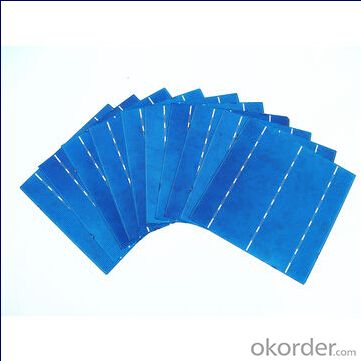
FAQ
We have organized several common questions for our clients,may help you sincerely:
1. What’s price per watt?
A: It’s depends on the quantity, delivery date and payment terms of the order. We can talk further about the detail price issue. Our products is high quality with lower price level.
2. Can you tell me the parameter of your solar cells?
We have different series of cells with different power output, both from c-si to a-si. Please take our specification sheet for your reference.
3.How do you pack your products?
We have rich experience on how to pack the panels to make sure the safety on shipment when it arrives at the destination.
4.Can you do OEM for us?
Yes, we can.
5.How long can we receive the product after purchase?
In the purchase of product within three working days, We will arrange the factory delivery as soon as possible. The perfect time of receiving is related to the state and position of customers. Commonly 7 to 10 working days can be served.
- Q: How do solar cells perform in areas with high levels of humidity?
- Solar cells can still perform efficiently in areas with high levels of humidity. However, excessive moisture in the air can cause a slight decrease in their overall performance due to increased resistive losses. It can also lead to the formation of water droplets on the surface of the solar panels, which can temporarily block sunlight and reduce energy production. To mitigate these effects, solar panels are typically designed to be water-resistant and have anti-reflective coatings to prevent water droplet formation. Overall, while humidity can have a minor impact on solar cell efficiency, it does not significantly hinder their ability to generate electricity.
- Q: How do solar cells compare to fossil fuel-based power generation?
- Solar cells are a more sustainable and environmentally friendly alternative to fossil fuel-based power generation. Solar cells harness the power of sunlight, a renewable energy source, to generate electricity, while fossil fuel-based power generation relies on the burning of finite fossil fuels like coal, oil, and gas. Solar cells produce clean energy, emit no greenhouse gases, and have little to no impact on climate change. Additionally, while fossil fuel-based power generation requires constant extraction and transportation of fuels, solar cells can be installed in various locations, making them more versatile and accessible. However, solar cells are currently less efficient and more expensive than fossil fuel-based power generation, which hinders their widespread adoption.
- Q: Can solar cells be used in powering communication networks?
- Yes, solar cells can be used to power communication networks. Solar cells convert sunlight into electricity, providing a sustainable and renewable energy source. This makes them ideal for powering remote communication networks, such as those in rural or off-grid areas, where access to traditional power sources may be limited. Additionally, solar-powered communication networks can reduce carbon emissions and dependency on fossil fuels, contributing to a more environmentally friendly solution.
- Q: How do solar cells handle electromagnetic pulses?
- Solar cells are generally not designed to handle electromagnetic pulses (EMPs) directly. EMPs can cause a sudden surge in electrical energy, which can potentially damage or destroy electronic devices, including solar cells. However, solar cells usually have built-in protection mechanisms and are often shielded by other components in a solar panel system, such as inverters or charge controllers, which can help mitigate the effects of EMPs. Additionally, the impact of EMPs on solar cells can vary depending on factors such as the magnitude and proximity of the pulse, as well as the quality and design of the solar cell system.
- Q: Can solar cells be used in transportation?
- Yes, solar cells can be used in transportation. Solar cells can be integrated into vehicles such as cars, buses, and trains to generate electricity and power various components, including lights, air conditioning, and even propulsion systems. This helps reduce reliance on fossil fuels, lowers emissions, and promotes sustainable transportation. Additionally, solar-powered vehicles can also have the ability to charge their batteries using sunlight, further extending their range and reducing the need for external charging infrastructure.
- Q: Can solar cells be used in commercial buildings?
- Yes, solar cells can be used in commercial buildings. In fact, many commercial buildings worldwide are increasingly incorporating solar panels to generate renewable energy and reduce their reliance on traditional power sources. This not only helps businesses save on electricity costs but also contributes to a more sustainable and environmentally friendly operation.
- Q: What is the lifespan of solar cells?
- The lifespan of solar cells can vary depending on various factors such as the type and quality of the cells, their usage and maintenance, and the overall conditions they are exposed to. However, on average, solar cells have a lifespan of around 25 to 30 years.
- Q: How do solar cells contribute to reducing carbon emissions?
- Solar cells contribute to reducing carbon emissions by converting sunlight directly into electricity without producing any greenhouse gases. This renewable energy source allows us to generate clean electricity, replacing the need for fossil fuel-based power generation that emits significant amounts of carbon dioxide and other pollutants. By adopting solar cells, we can reduce our dependence on fossil fuels and mitigate the harmful effects of carbon emissions on the environment and climate change.
- Q: Can solar cells be used in electric fence systems?
- Yes, solar cells can be used in electric fence systems. Solar cells convert sunlight into electricity, which can be used to power the electric fence. This eliminates the need for traditional power sources such as batteries or connecting to the electrical grid, making it a more sustainable and cost-effective option.
- Q: What is the impact of solar cell installations on greenhouse gas emissions?
- Solar cell installations have a significant positive impact on reducing greenhouse gas emissions. By harnessing the power of the sun to generate electricity, solar cells eliminate the need for fossil fuel-based energy sources, which are major contributors to greenhouse gas emissions. As more solar cells are installed and integrated into the energy grid, the overall emissions from the electricity sector decrease, making solar cell installations an important solution towards mitigating climate change.
Send your message to us
Buy Solar Cells in Bulk - Polycrystalline Solar Cells Series C 16.80%
- Loading Port:
- Shanghai
- Payment Terms:
- TT OR LC
- Min Order Qty:
- 3000 pc
- Supply Capability:
- 300000 pc/month
OKorder Service Pledge
OKorder Financial Service
Similar products
Hot products
Hot Searches
Related keywords
